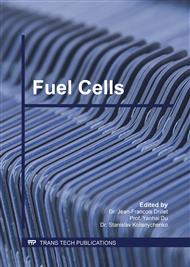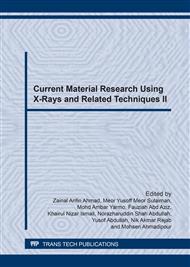[1]
S. Daneshmandi, P. Sohrabi, H. Salamati, M. Ranjbar, Effect of oxygen pressure on structural and electrical properties of Ba0. 5Sr0. 5Co0. 8Fe0. 2O3-δ/SrTiO3(200) by reactive pulsed laser deposition, Mater. Lett. 109 (2013) 233–236.
DOI: 10.1016/j.matlet.2013.07.086
Google Scholar
[2]
R.B. Nuernberg, M.R. Morelli, Synthesis of BSCF perovskites using a microwave-assisted combustion method, Ceram. Int. 42(3) (2016) 4204–4211.
DOI: 10.1016/j.ceramint.2015.11.094
Google Scholar
[3]
F. Shen, K. Lu, Comparative study of La0. 6Sr0. 4Co0. 2Fe0. 8O3, Ba0. 5Sr0. 5Co0. 2Fe0. 8O3 and Sm0. 5Sr0. 5Co0. 2Fe0. 8O3 cathodes and the effect of Sm0. 2Ce0. 8O2 block layer in solid oxide fuel cells, Int. J. Hydrogen Energy. 40(46) (2015).
DOI: 10.1016/j.ijhydene.2020.10.113
Google Scholar
[4]
Z. Shao, S.M. Haile, A high-performance cathode for the next generation of solid-oxide fuel cells, Nature. 431(7005) (2004) 170–173.
DOI: 10.1038/nature02863
Google Scholar
[5]
D. Rembelski, J.P. Viricelle, L. Combemale, M. Rieu, Characterization and comparison of different cathode materials for SC-SOFC: LSM, BSCF, SSC, and LSCF, Fuel Cells. 12(2) (2012) 256–264.
DOI: 10.1002/fuce.201100064
Google Scholar
[6]
S. Zeljkovic, T. Ivas, S. Vaucher, D. Jelic, L. Gauckler, The changes of Ba0. 5Sr0. 5Co0. 8Fe0. 2O3-δ perovskite oxide on heating in oxygen and carbon dioxide atmospheres, J. Serbian Chem. Soc. 79(9) (2014) 1141–1154.
DOI: 10.2298/jsc131024018z
Google Scholar
[7]
P. Liu, J. Kong, Q. Liu, X. Yang, S. Chen, Relationship between powder structure and electrochemical performance of Ba0. 5Sr0. 5Co0. 8Fe0. 2O3 − δ cathode material, J. Solid State Electrochem. 18 (2014) 1513–1517.
DOI: 10.1007/s10008-013-2374-y
Google Scholar
[8]
Y. He, L. Fan, M. Afzal, M. Singh, W. Zhang, Y. Zhao, J. Li, B. Zhu, Cobalt oxides coated commercial Ba0. 5Sr0. 5Co0. 8Fe0. 2O3−δ as high performance cathode for low-temperature SOFCs, Electrochim. Acta. 191 (2016) 223–229.
DOI: 10.1016/j.electacta.2016.01.090
Google Scholar
[9]
M. Brisotto, F. Cernuschi, F. Drago, C. Lenardi, P. Rosa, C. Meneghini, M. Merlini, C. Rinaldi, High temperature stability of Ba0. 5Sr0. 5Co0. 8Fe0. 2O3-δ and La0. 6Sr0. 4Co1-yFeyO3-δ oxygen separation perovskite membranes, J. Eur. Ceram. Soc. 36(7) (2015).
DOI: 10.1016/j.jeurceramsoc.2016.01.029
Google Scholar
[10]
Z. Zhao, L. Liu, X. Zhang, B. Tu, D. Ou, Carbonates formed during BSCF preparation and their effects on performance of SOFCs with BSCF cathode, Int. J. Hydrogen Energy. 37(24) (2012) 19036–19044.
DOI: 10.1016/j.ijhydene.2012.09.142
Google Scholar
[11]
H.S. Hong, S. Lee, Fabrication and characterization of 900 °C-sintered Ni/Cu/YSZ cermet high temperature electrolysis cathode material prepared by high-energy ball-milling method, J. Alloys Compd. 538 (2012) 201–204.
DOI: 10.1016/j.jallcom.2012.06.002
Google Scholar
[12]
F.S. Torknik, A. Maghsoudipour, M. Keyanpour-Rad, G.M. Choi, S.H. Oh G.Y. Shin, Microstructural refinement of Ni/Ce0. 8Gd0. 2O2−δ anodes for low-temperature solid oxide fuel cell by wet infiltration loading of PdCl2, Ceram. Int. 40(8) (2014).
DOI: 10.1016/j.ceramint.2014.04.075
Google Scholar
[13]
C. Niedrig, S. Taufall, M. Burriel, W. Menesklou, S. F. Wagner, S. Baumann, E. Ivers-Tiffée, Thermal stability of the cubic phase in Ba0. 5Sr0. 5Co0. 8Fe0. 2O3-δ (BSCF)1, Solid State Ionics. 197(1) (2011) 25–31.
DOI: 10.1016/j.ssi.2011.06.010
Google Scholar
[14]
E. Bucher, A. Egger, G.B. Caraman, W. Sitte, Stability of the SOFC cathode material (Ba, Sr)(Co, Fe)O3−δ in CO2-containing atmospheres, J. Electrochem. Soc. 155(11) (2008) B1218.
DOI: 10.1149/1.2981024
Google Scholar
[15]
J. Coates: in Interpretation of Infrared Spectra, A Practical Approach , edited by R.A. Meyers, John Wiley & Sons, Inc. (2000).
Google Scholar
[16]
H. A. Rahman, A. Muchtar, N. Muhamad, H. Abdullah, Structure and thermal properties of La0. 6Sr0. 4Co0. 2Fe0. 8O3−δ–SDC carbonate composite cathodes for intermediate- to low-temperature solid oxide fuel cells, Ceram. Int. 38(2) (2012) 1571–1576.
DOI: 10.1016/j.ceramint.2011.09.043
Google Scholar
[17]
A. Yan, V. Maragou, A. Arico, M. Cheng, P. Tsiakaras, Investigation of Ba0. 5Sr0. 5Co0. 8Fe0. 2O3- δ based cathode SOFC. II. The effect of CO2 on the chemical stability, Appl. Catal. B Environ. 76(3–4) (2007) 320–327.
DOI: 10.1016/j.apcatb.2007.06.010
Google Scholar



